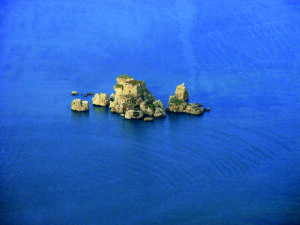 The Rock of Rovigliano, also known as Petra Herculis, is a small limestone islet in the Gulf of Naples that encapsulates centuries of history, legend, and architecture on its modest territory of just 6,000 square meters. Located off the mouth of the Sarno River, on the border between Castellammare di Stabia and Torre Annunziata, it is now uninhabited but holds traces of an ancient temple, medieval monasteries, a watchtower, and even a twentieth-century restaurant.
The Rock of Rovigliano, also known as Petra Herculis, is a small limestone islet in the Gulf of Naples that encapsulates centuries of history, legend, and architecture on its modest territory of just 6,000 square meters. Located off the mouth of the Sarno River, on the border between Castellammare di Stabia and Torre Annunziata, it is now uninhabited but holds traces of an ancient temple, medieval monasteries, a watchtower, and even a twentieth-century restaurant.
Geologically, the rock shares the limestone-dolomitic composition of the Lattari Mountains and perhaps represents the summit of an ancient mountain that sank following the collision of the African and Eurasian plates. The structure is composed of dolomitic and limestone sedimentary rocks similar to the Lattari Mountains, suggesting a common origin. It is conceivable that the islet represents the peak of an ancient relief that slid into the sea, a process linked to the collision between the African and Eurasian plates that shaped the entire Campanian plain. In antiquity, the rock was called “Petra Herculis”: according to legend, Hercules broke off a block from Mount Faito after his tenth labor and threw it into the sea, giving rise to the islet (a story also reported in the accounts of Pliny the Elder, who mentioned the place before perishing in the eruption of 79 A.D. right near the rock). During the Roman era, a temple dedicated to Hercules stood there, of which a section of wall in opus reticulatum remains today.
The name “Rovigliano” first appears in a bull of Pope Innocent III (early 13th century), where the location is referred to as Rubellanium, perhaps from the surname of the gens Rubilia or the Latin term “robilia” for the vetchlings that grew there. Between the 6th and 12th centuries, the islet hosted private dwellings and then a Cistercian monastery reserved for young women dedicated to monastic life.
In the 16th century, a watchtower was built to defend against Saracen raids; the walls and ruins are still visible. After 1860, the rock became state property, and in 1931, a restaurant was opened there, but it closed quickly, leaving few traces.
Its mythical charm attracts enthusiasts of archaeology and classical folklore, making the Rock of Rovigliano a symbol of the ancient roots of the Vesuvian territory. Today, the islet is reachable only by sea, with boat tours from Torre Annunziata or Castellammare di Stabia, and is a destination for tourist excursions, preserving the intact charm of its Herculean legend.




